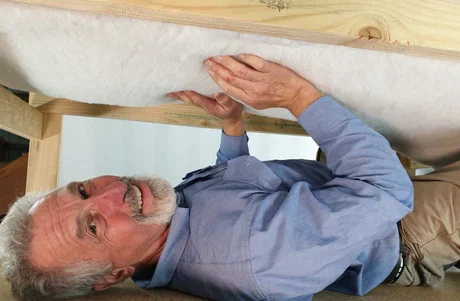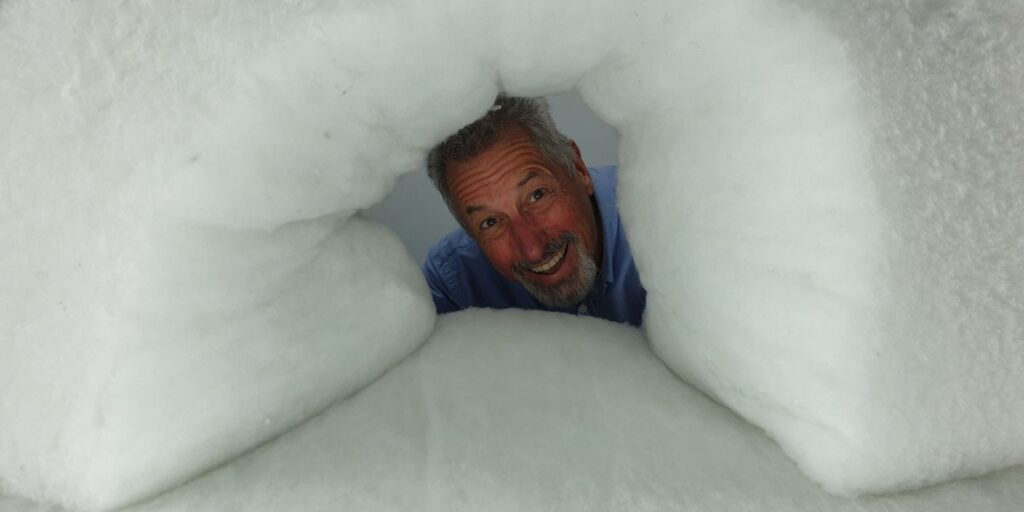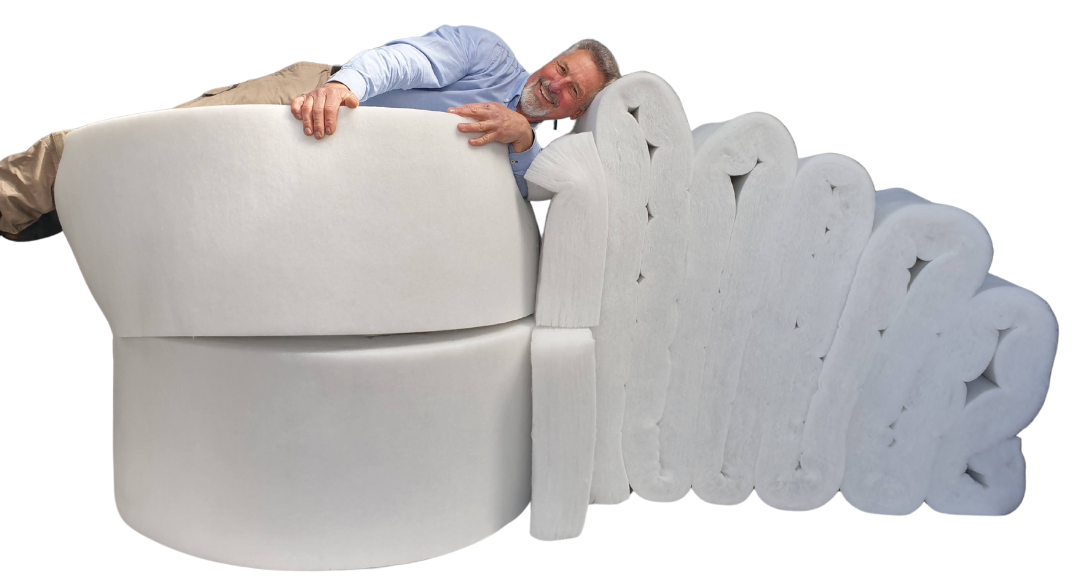
Table of Contents
Cold Feet, Big Ideas!
Back in the early 2000s, underfloor insulation simply didn’t exist. Not in the way it does now. There were no kits, no how-to guides, and definitely no tradies offering it as a service. No “Underfloor Insulation” section at Bunnings.
After retrofitting our own home (which had a very particular kind of underfloor structure), we became a little obsessed. We started sorting our friends into two camps: weatherboarders and brick veneer-ers.
Not for a dinner party. For science
The Perfect Test Case
We needed real homes (and brave humans) to test our retrofit ideas on.
Enter: our mates at the base of Mount Macedon.
Classic weatherboard. Freezing. No insulation.
They were desperate for warmth.
“Wanna be our guinea pigs?” we asked.
“As long as we stop freezing,” they replied.
Deal.

DIY Science (with a Cool Room)
By then, we’d already spent six months building a heat chamber, hiring a cool room (as you do), and testing insulation products to figure out their actual thermal performance — not just what the packaging said.
Polyester was the clear winner.
So we armed ourselves with ceiling batts and crawled into a subfloor that felt more like a wombat warren. It was cold, cramped, and deeply unglamorous. We hauled in hundreds of batts, one at a time, and stapled them into place.
Was it awkward? Yes.
Was it exhausting? You bet.
Was it worth it? Absolutely.
But the process? It needed serious work.
A Sweaty Eureka Moment
A few months later, Maurice was elbow-deep in a Brunswick ceiling in the middle of summer. It was that dead zone between Christmas and New Year — when stock is scarce and the weather is cruel.
The only insulation available was fresh out of the ovens: not pre-cut batts, but long, continuous rolls.
It was a game-changer.
No fiddling. No gaps. Just smooth, fast, efficient installs.
Somewhere between the sweat and the swearing, the penny dropped:
“This would be perfect under a floor.”

From Prototype to Product
We went back to the manufacturer with a cheeky request:
“Could you make those rolls a bit wider? Wide enough to fit between floor joists?”
To our delight, they said yes.
And just like that, Australia’s first polyester underfloor insulation roll was born.
The Tinkering Never Stopped
From there, we refined everything.
✅ We upped the R-values — from R1.5 to R2.0, then R2.5
✅ We scrapped what didn’t work (farewell foil layers — you were expensive, fiddly, and kind of a pain)
✅ We made the rolls thicker, denser, and easier to install
✅ We built a system that actually stayed put once installed
The Vacuum-Pack Problem
But then came the battle over vacuum-packing.
As insulation got better (read: puffier), manufacturers wanted to vacuum pack it for shipping and storage. Great for freight. Terrible for performance — because insulation that is vacuum packed for a period of time (as yet unknown) does not bounce back.
We held firm for years, insisting on full-loft product. Eventually, the option disappeared. We were gutted. After all the years of collaboration, our flagship product was gone.
A Pandemic, A Pivot, and a Whole New Path
In 2020, the pandemic hit. Face-to-face installs became tricky, so we pivoted — hard — into DIY. We poured everything we knew into helping people install underfloor insulation themselves, without the rookie mistakes.
We even launched a whole new website:
www.UnderfloorInsulationAustralia.com.au
(Yep, it’s a mouthful. But it does what it says on the tin.)

Not All Insulation is Created Equal
Since going DIY, we’ve tested insulation from all kinds of manufacturers — and we’ve seen it all. Few things are more disheartening than pulling out a bag marked “R2.5” and finding something that looks more like … well not R2.5 . 😔

Knock knock? It’s Polymax by Bradford CSR
In early 2020, we started working with Bradford CSR.
They’re a big fish — but one of the good ones.
They actually listen. And they make Polymax, a genuinely high-performance, R2.5 polyester underfloor insulation that lives up to its label.
What it says on the bag is what’s in the bag.
No surprises. No explosions (well, not usually — but at least the bags don’t blow up when tossed off a truck).
And critically — it works.
Polymax is compressed (not vacuum-sealed), regains its full loft after a short rest, and holds its shape for years. It’s reliable. It’s consistent. And it’s available right across Australia at a fair price.

Still Improving, 22+ Years On
These days, Polymax R2.5 Underfloor Insulation is trusted in homes across the country.
But we’re not done.
After 22+ years in thermal efficiency, we’re still working behind the scenes — with manufacturers, installers, and DIYers — to make insulation even better. We’re still tweaking the product. Still improving the packaging. Still refusing to accept anything less than actually works.
Because we’re not just resellers.
We’re the ones who helped invent underfloor insulation in Australia.
And we’re still here — making sure it keeps you warm. For good.
People Also Ask
⇒ Did underfloor insulation really not exist in the early 2000s?
Yes — it wasn’t something offered in a standard retrofit or by most tradies. There were ceiling batts and wall insulation, but nothing specifically designed for underfloor use, especially not in DIY roll format. We change that.
⇒ What makes polyester underfloor insulation better than other types?
Polyester is non-itchy, easy to handle, resistant to moisture and rodents, and maintains its shape over time. Unlike some other materials, it doesn’t sag or break down and is not impacted by a water spill, which means it continues to perform for years — no nasty surprises.
⇒ What’s the difference between compressed and vacuum-packed insulation?
Compressed insulation is gently squashed for shipping but regains its full loft after unpacking. Vacuum-packed insulation has been flattened with as much air removed as possible. This is particularly problematic if it is vacuum packed when the rolls are still hot from the ovens. Vacuum packed insulation often does not bounce back properly — which means it won’t insulate effectively – and certainly not to the R value that you have paid for.
⇒ Why is loft so important in insulation?
Loft is the thickness and fluffiness that traps air — and that trapped air is what slows down heat transfer. If insulation loses its loft, it loses its performance. That’s why we’ve always insisted on products that recover properly.
⇒ Can I install underfloor insulation myself?
Absolutely — if your home has enough clearance under the floor (ideally 400mm or more), it’s very doable as a DIY job. We have everything you need to help you do it right, with fewer swear words.
⇒ How do I know if my house needs underfloor insulation?
If you have timber floors and they are cold in winter, you have gaps in floorboards, or your heating never seems to keep up — there’s a good chance your home would benefit from underfloor insulation.

Do you want to know more about us and what we do?
Maybe you want to read this one next:
The Story of Draught Dodgers – A Tale of Ingenuity and Innovation

Recent Comments